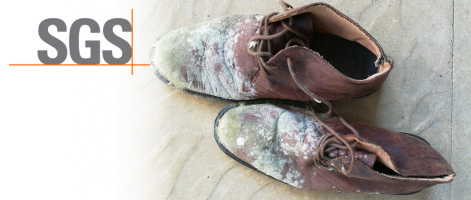
Category: General
Country: India
Region: South Asia
SGS offers cutting-edge antimicrobial testing services, meticulously analyzing products to guarantee their safety and effectiveness against microbial threats.
By SGS
GTS Internal Newsfeed
13th October 2023
Footwear and leather, comprising various materials, naturally attract microbial growth due to moisture and bodily contact. These products, constantly in touch with human bodies, create ideal conditions for microbes to thrive, leading to issues like odor and staining. Understanding these natural traits is crucial for effective antimicrobial solutions.
Challenges in footwear and leather:
Microbial Attraction: Footwear and leather, with their diverse components, offer a breeding ground for microbes due to their interaction with body fluids.
Aesthetic and Functional Impacts: This microbial growth can result in unpleasant odors, sliminess, and discoloration, affecting the product’s quality and durability.
SGS offers cutting-edge antimicrobial testing services, meticulously analyzing products to guarantee their safety and effectiveness against microbial threats. With our comprehensive testing approach, we assess not only antimicrobial properties but also various quality aspects, ensuring your products meet the highest international standards.
TEST METHODS:
1. Antifungal Property - ISO 20150
A quantitative test specifically designed for assessing the antifungal or antimicrobial claims of footwear components.
Utilizes the Dynamic Challenge principle and Plate count method to determine the antifungal activity ratio.
2. Antifungal Activity - AATCC TM30-2017e
Evaluates the susceptibility of footwear materials to mildew and rot resistance.
Provides flexibility by allowing tests with or without 3% glucose, with the glucose-based test requiring a longer duration (7 days).
3. Assessment of Rot Retardant Finishing - ISO 11721-1
Determines the resistance of cellulose-containing footwear materials to soil-based microorganisms using the Soil Burial method.
Essential for assessing chemically treated samples against soil microbial action.
4. Antimicrobial Property - AATCC TM100-2019
Quantitatively assesses the ability of footwear materials to inhibit or kill microorganisms within a 24-hour contact period.
Provides a quantitative measure of antibacterial activity.
5. Antimicrobial Property - AATCC TM147-2011(2016)
Offers a rough estimate of antibacterial activity using the Parallel Streak method.
Designed to determine the effectiveness of diffusible antimicrobial agents on treated footwear specimens.
Why SGS?
SGS, with its global network of experts and advanced testing laboratories, is your trusted partner in ensuring the quality, safety, and antimicrobial efficacy of footwear and leather products. Our comprehensive testing services and in-depth analysis help you meet international regulatory standards, guaranteeing top-notch performance and customer satisfaction.
Elevate the antimicrobial performance of your footwear and leather products with SGS expertise. Contact us now to discover customized solutions and unparalleled testing services for your products.
Want to contact SGS? You can send your enquiry here.
Copyrights © 2025 GLOBAL TEXTILE SOURCE. All rights reserved.